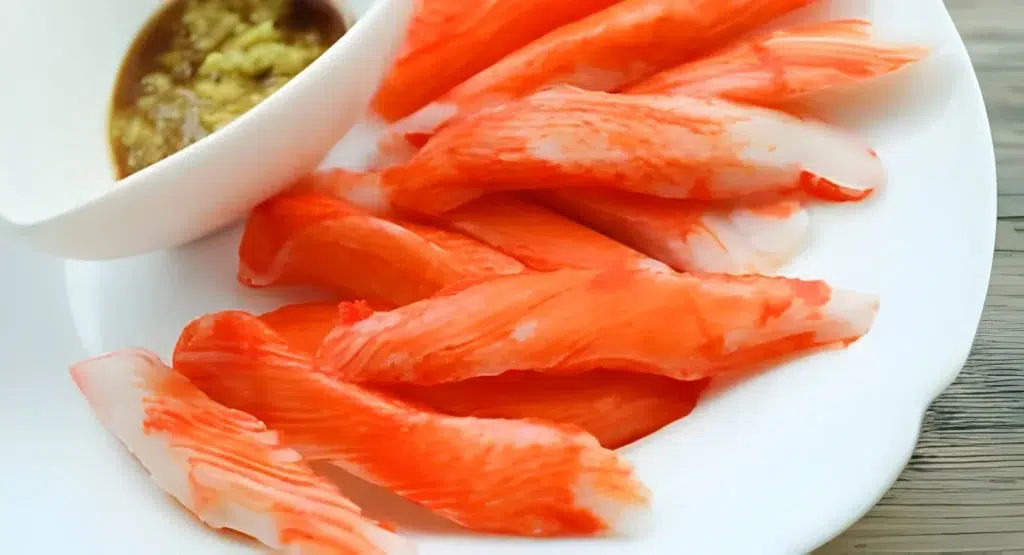Kani: A Journey Through Flavor and Sustainability

Introduction
Kani, frequently perceived as just an alternative to its more expensive counterpart, real crab meat, achieves far more than filling the gap. It serves as a bridge, melding the worlds of accessibility and gourmet seafood. Beyond its practical appeal, Artificial crab harbors a rich history rooted in Japanese culinary practices, reflecting centuries of innovation and sustainability. This journey from humble beginnings to global recognition exemplifies Kani’s unique role in the culinary landscape. As we delve deeper, we uncover not only the versatility and nutritional benefits of Crab sticks but also its contribution to eco-conscious dining. Thus, our exploration into Kani’s world promises a discovery of flavors that resonate with the principles of modern, responsible eating.
The Essence of Kani
Unpacking Kani’s Identity
Unpacking Kani’s Identity begins by tracing its origins back to Japan, a country renowned for its meticulous approach to food. The concept of Kani, primarily known outside Japan as imitation crab, is deeply interwoven with the nation’s innovative spirit in culinary arts. This invention not only showcases Japan’s ability to create versatile and accessible food options but also reflects a broader philosophy of sustainability and resourcefulness in the face of scarcity.
Kani’s development was propelled by the desire to make crab-like flavors and textures available to a wider audience, without the high costs associated with real crab meat. Utilizing surimi, a fish paste made from white-fleshed fish, Japanese food scientists were able to mimic the delicate taste and flaky texture of crab. This process involved not just technical expertise in food processing but also a deep understanding of flavor profiles and consumer preferences.
Today, Crab sticks stands as a hallmark of Japanese innovation in the global culinary landscape. Its creation was not merely about replicating the crab’s flavor but also about providing a sustainable and economical alternative. As such, Kani’s identity is rooted in the principles of ingenuity, adaptability, and respect for natural resources, embodying the essence of Japanese culinary tradition while catering to the tastes and needs of people worldwide.
The Making of Kani
The process of making Artificial crab from Surimi is a fascinating blend of tradition and modern technology. Surimi, essentially a fish paste, is crafted from white-fleshed fish like pollock or hake, which are abundant and sustainably sourced. The fish are meticulously cleaned, deboned, and then ground into a fine paste. This paste is then flavored and colored to mimic the delicate taste and texture of crab meat, a testament to culinary creativity and the innovative use of simple, sustainable ingredients.
Moreover, this process does not just transform fish into a crab substitute; it elevates the ingredient, turning it into a versatile and beloved component of many dishes worldwide. The creation of Crab sticks involves a careful balance of flavoring, ensuring that the end product is not only sustainable but also delicious. Thus, the making of Kani embodies a profound respect for natural resources, showcasing how culinary practices can contribute to a more sustainable food system. Through this, Kani’s production stands as a shining example of how art meets science in the kitchen, creating something that is much greater than the sum of its parts.
Culinary Applications of Kani
Broadening the Palette
Kani shines with its versatility, enhancing many dishes. Its nuanced flavor adds depth. Its texture suits both hot and cold recipes well. Thus, Kani invites kitchen innovation and experimentation.
This ingredient’s unique texture mimics real crab meat. It blends seamlessly into various dishes. From crisp summer salads to warm seafood chowders, Crab sticks enriches with complexity. Chefs and home cooks alike explore beyond traditional recipes. They infuse a hint of the sea into their dishes.
Kani adopts flavors well, fitting into both subtle and bold meals. It stars in sushi rolls and spicy dips. Kani complements other ingredients, never overpowering. This balance makes Kani a gateway to culinary exploration. It encourages reimagining seafood’s role in cooking.
Nutritional Profile
Kani is not just tasty; it’s also nutritious. It’s low in calories but high in protein. This makes it an ideal choice for diet-conscious individuals. Kani also packs vital minerals and vitamins. These include phosphorus for strong bones and selenium for cell protection. It’s rich in omega-3 fatty acids too, boosting heart health and reducing inflammation. Thus, Artificial crab is perfect for enriching diets without compromise. Its versatility in recipes ensures eating healthily is both enjoyable and diverse.
Kani and Cultural Integration
Bridging Cuisines
Kani bridges worlds in the culinary realm. Its versatility shines, making it perfect for fusion cuisine. It blends East Asian delicacy with Western boldness, creating new flavors. Kani transforms meals, linking diners to distant tastes comfortably. It pushes us to explore and mix culinary traditions. This enriches global cuisine and celebrates our diverse culinary heritage. Chefs and home cooks find in Kani a tool for unity through diverse dishes.
Sustainability and Ethics
In the realm of culinary sustainability, Kani stands out for its forward-thinking approach to seafood consumption. By utilizing fish species that are abundant and sustainably harvested, Crab sticks offers an ethical alternative to traditional seafood. This method not only helps in maintaining the ecological balance of our oceans but also ensures that the pressure on overfished species is significantly reduced. Furthermore, the production of Kani highlights a commitment to responsible sourcing practices, aligning with global efforts to protect marine biodiversity.
Moreover, Kani’s role in promoting sustainable eating habits extends beyond its ingredients. It serves as an example of how culinary innovation can lead to more environmentally friendly eating choices. Consumers who opt for Kani are inadvertently supporting sustainable fishing practices, thereby contributing to the conservation of ocean resources. As such, Kani is not just a delicious ingredient; it embodies a conscientious choice towards a more sustainable and ethical approach to seafood, making it a pivotal component in the movement towards a more sustainable future in culinary consumption.
Mastering Kani in the Kitchen
Tips for Culinary Success
Embracing Kani in your culinary adventures means diving into a world of unique textures and flavors that can transform your dishes. First and foremost, understanding Kani’s delicate, slightly sweet profile is key. This allows you to pair it with ingredients that complement or contrast its flavor effectively. For example, pairing Kani with creamy avocado or crisp cucumber in sushi rolls enhances its oceanic essence.
Additionally, consider the texture of Kani, which is tender yet firm enough to hold its own in various dishes. This versatility means that Kani can be the star in a wide array of culinary creations, from salads and wraps to more complex dishes like pasta and casseroles. The key to success is experimentation; don’t hesitate to incorporate Artificial crab into your favorite recipes or to try it in new, innovative ways.
By embracing the diversity Kani offers, you open up a world of culinary possibilities. Whether it’s through traditional dishes or your unique creations, Kani can elevate your cooking, bringing a touch of the sea to your table. Thus, experimenting with Kani not only broadens your culinary repertoire but also allows you to enjoy the rich flavors and textures that this remarkable ingredient has to offer.
A Gateway to Exploration
Kani is not just an ingredient; it’s a gateway to culinary exploration. Each dish with Crab sticks opens up new flavor discoveries and techniques. Thus, Kani propels us on a culinary journey. It’s about more than Kani itself. It’s how Artificial crab enhances other ingredients and brings global culinary traditions into our kitchens. Cooking with Artificial crab boosts creativity. It allows for innovation in dishes, from sushi to fusion appetizers and revamped salads. Kani turns meals into a canvas, blending the old with the new. Through Artificial crab , we expand our cooking skills and savor the joy of eating.
Conclusion
In conclusion, Kani is more than a culinary delight. It offers a blend of flavors and textures, showcasing innovation and sustainability. This ingredient bridges culinary traditions, enhancing our meals with diversity and creativity. As we explore Kani’s possibilities, it encourages us to embrace varied cooking practices. Kani also promotes sustainable eating, reminding us of our environmental responsibilities. Let’s celebrate Kani as a catalyst for exploration and connection. It turns each meal into an adventure and a step towards a sustainable future.
RELATED ARTICLE
- Top Imitation Crab Recipes: Delicious & Easy Seafood Dishes – This article could provide readers with practical uses for Kani in various dishes, showcasing its versatility in cooking.
- What is the Best Way to Eat Imitation Crab Meat? – Offers insight into different culinary approaches to enjoying imitation crab, which is what Kani is often made from.
- Kani Kama – Directly related, this article likely discusses Crab sticks Kama in detail, which is another name for imitation crab sticks made from processed seafood.
- Eating Imitation Crab Raw: Guide – Could provide valuable safety and culinary information relevant to Kani consumption.
- Can You Cook Imitation Crab? – Since Kani is often used as an imitation crab, this article can be useful for readers interested in cooking methods specific to this ingredient.
